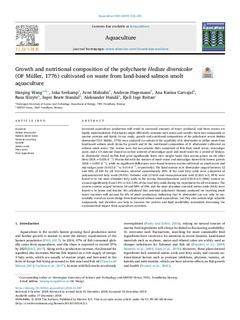| dc.contributor.author | Wang, Haiqing | |
| dc.contributor.author | Seekamp, Inka | |
| dc.contributor.author | Malzahn, Arne | |
| dc.contributor.author | Hagemann, Andreas | |
| dc.contributor.author | Carvajal, Ana Karina | |
| dc.contributor.author | Slizyte, Rasa | |
| dc.contributor.author | Standal, Inger Beate | |
| dc.contributor.author | Handå, Aleksander | |
| dc.contributor.author | Reitan, Kjell Inge | |
| dc.date.accessioned | 2019-02-08T07:39:25Z | |
| dc.date.available | 2019-02-08T07:39:25Z | |
| dc.date.created | 2019-01-18T14:21:40Z | |
| dc.date.issued | 2019-03-15 | |
| dc.identifier.citation | Aquaculture. 2019, 502 232-241. | nb_NO |
| dc.identifier.issn | 0044-8486 | |
| dc.identifier.uri | http://hdl.handle.net/11250/2584498 | |
| dc.description.abstract | Increased aquaculture production will result in increased amounts of waste produced, and these wastes are highly underexploited. Polychaetes might effectively consume such waste and transfer them into compounds as marine proteins and lipids. In our study, growth and nutritional composition of the polychaete worm Hediste diversicolor (O.F. Müller, 1776) were analyzed to evaluate i) the capability of H. diversicolor to utilize waste from land-based salmon smolt farms for growth and ii) the nutritional composition of H. diversicolor cultivated on salmon smolt waste. The worms were fed iso‑carbonic diets comprised of fish feed, smolt waste, microalgae paste, and a 1:5 mixture (based on carbon content) of microalgae paste and smolt waste for a period of 30 days. H. diversicolor reared on fish feed grew significantly faster (wet weight basis) than worms grown on the other diets (SGR = 0.025 d−1). Worms fed with the mixture of smolt waste and microalgae showed the lowest growth (SGR = 0.003 d−1), while no significant differences were found between worms cultivated on smolt waste and microalgae paste (0.012 d−1vs. 0.014 d−1, respectively). The lipid content in H. diversicolor ranged between 12 and 16% of DW for all treatments, whereof approximately 45% of the total fatty acids were comprised of polyunsaturated fatty acids (PUFA). Palmitic acid (C16:0) and eicosapentaenoic acid (C20:5 n-3; EPA) were found to be the most abundant fatty acids in the worms. Docosahexaenoic acid (C20:6 n-3; DHA) content increased significantly from 1.5% to 4.6–7.8% of the total fatty acids during the experiment for all treatments. The protein content ranged between 54 and 58% of DW, and the most abundant essential amino acids (EAA) were found to be lysine and leucine. We calculated that potential polychaete biomass produced via recycling smolt waste nutrients will account for 8% of smolt production, indicating that H. diversicolor can not only be successfully reared on waste sludge from land-based salmon smolt aquaculture, but they also contain high valuable compounds, and therefore can help to increase the protein and lipid availability meanwhile decreasing the environmental impact from aquaculture activities. | nb_NO |
| dc.language.iso | eng | nb_NO |
| dc.publisher | Elsevier Ltd | nb_NO |
| dc.rights | Attribution-NonCommercial-NoDerivatives 4.0 Internasjonal | * |
| dc.rights.uri | http://creativecommons.org/licenses/by-nc-nd/4.0/deed.no | * |
| dc.subject | Hediste diversicolor | nb_NO |
| dc.subject | Salmon smolt waste | nb_NO |
| dc.subject | Nutrient recycling | nb_NO |
| dc.subject | Growth | nb_NO |
| dc.subject | Amino acids | nb_NO |
| dc.subject | Fatty acids | nb_NO |
| dc.subject | Feed ingredients | nb_NO |
| dc.title | Growth and nutritional composition of the polychaete Hediste diversicolor (OF Müller, 1776) cultivated on waste from land-based salmon smolt aquaculture | nb_NO |
| dc.type | Journal article | nb_NO |
| dc.type | Peer reviewed | nb_NO |
| dc.description.version | publishedVersion | nb_NO |
| dc.rights.holder | © 2018 The Authors. Published by Elsevier B.V. | nb_NO |
| dc.source.pagenumber | 232-241 | nb_NO |
| dc.source.volume | 502 | nb_NO |
| dc.source.journal | Aquaculture | nb_NO |
| dc.identifier.doi | 10.1016/j.aquaculture.2018.12.047 | |
| dc.identifier.cristin | 1660417 | |
| cristin.unitcode | 7566,6,0,0 | |
| cristin.unitcode | 7566,2,0,0 | |
| cristin.unitname | Miljø og nye ressurser | |
| cristin.unitname | Sjømatteknologi | |
| cristin.ispublished | true | |
| cristin.fulltext | original | |
| cristin.qualitycode | 1 | |

